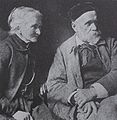Albert Anker
Albert Samuel Anker (born April 1, 1831 in Ins , Canton Bern , Switzerland; † July 16, 1910 ibid) was a Swiss painter , graphic artist and genre painter of Swiss folk life.
Life
Albert Anker was born as the second of three children of the veterinarian Samuel Anker (1791-1860) and his wife Marianne Elisabeth Anker, née Gatschet (1802-1847), on April 1, 1831 in Ins in the Bernese Seeland . Between 1845 and 1848 he got his first private drawing lessons from Louis Wallinger in Neuchâtel . In 1847, Anker's brother Friedrich Rudolf (* 1828) and his mother died in the same year, and his sister just five years later.
From 1849, Anker attended high school in Bern. He lived with his uncle Matthias Anker (1788–1863). In a letter dated June 9th to his friend Bachelin, Anker explains in detail about painting. From May 11th to the summer of 1854 he was a member of the Swiss Zofinger Association .
In 1851, Anker passed the Matura and began to study theology in Bern. In September he traveled to Paris for the first time, where he got to know and appreciate the works of Eustache Le Sueur and Nicolas Poussin , among others . From autumn 1852 to spring 1854, Anker continued his studies at the University of Halle .
On December 25, 1853, in a letter to his father, Anker expressed his desire to finish his studies and become a painter. In the spring, Anker returned to Bern and initially continued his studies. With the chalk drawing Smoking Age he took part for the first time in an exhibition of the Swiss Art Association in Bern.
When Anker got his father's permission to drop out of college in 1854, he moved to Paris . He became a student of the Swiss painter Charles Gleyre , with whom Pierre-Auguste Renoir also studied from 1861 . Between 1855 and 1860 he attended the École nationale supérieure des beaux-arts de Paris and from 1859 to 1885 was regularly represented with his pictures in the Paris Salon . Between 1856 and 1862 he traveled to Brittany , the Black Forest and Italy , which was followed by several trips to Italy, Germany , France and Belgium .
When his father became seriously ill in 1859 and died at the end of 1860, Anker took over the house in Ins. At first he only spent the summer months there, the winter time in Paris. In 1890 he gave up his residence in Paris and moved entirely to Ins.
In 1866 he became a member of the “Society of Swiss Painters and Sculptors”. Anker worked as a faience painter from 1866 to 1882 . From 1870 to 1874, Anker was a member of the Grand Council of the Canton of Bern, where he campaigned for the construction of the Bern Art Museum , which opened in 1873.
Albert Anker was honored many times for his works, for example he was one of the organizers of the Swiss department at the World Exhibition in Paris in 1878 , was made a knight of the French Legion of Honor in the same year and was elected to the Federal Art Commission in 1888 , where he was a member until 1892 and from 1895 to 1898 was active. From 1891 to 1901 he was a member of the Federal Commission of the Gottfried Keller Foundation . On November 17, 1900, he was awarded an honorary doctorate from the University of Bern .
In 1901, Anker suffered a severe stroke, which paralyzed his right hand. This handicap made it difficult for Anker to work on large oil paintings. In a comfortable working position for him - sitting on a chair with the picture carrier on his knees - he painted up to 600 watercolors, whereby the preliminary drawing with pencil was reduced to a minimum. In 1906 Jakob August Heer made a bust of Anker.
Albert Anker died in Ins on July 16, 1910. In his memory, exhibitions were held in the “Musée d'art et d'histoire” in Neuchâtel from November 1st to 30th, 1910 and in the Kunstmuseum Bern from January 15th to February 12th, 1911. On the occasion of the 100th anniversary of his death, the Museum Oskar Reinhart in Winterthur showed the Albert Anker exhibition . Beautiful world. On the 100th anniversary of death.
family
On December 6, 1864, Anker married Anna Rüfli (1835–1917) from Lengnau, a friend of his late sister Louise (1837–1852), in Twann. He had six children with Anna Rüfli: Louise (1865–1954), Sophie Marie (1872–1950), Cécile (1877–1957), Rudolf (1867–1869), Emil (1870–1871) and Moritz (1874–1931) . Louise married the businessman Max Oser in Basel in 1884, and Marie married the organist Albert Quinche in Neuchâtel in 1892. Cécile married the professor of dermatology Charles Du Bois in 1901 .
Anker painted his children and grandchildren repeatedly, his wife occasionally appears on sketches. In the picture “ Die Länderkinder ”, Anker captured her: She is the woman with the white hood in front of the rear car. The boy in the light-colored smock to whom the dark-clad lady turns is Anker's youngest son Moritz.
Albert and Luise Anker, daguerreotype around 1850
plant
Anker painted portraits of children, scenes with religious and historical figures, still lifes and rural landscapes. He differed from his teacher Gleyre mainly in that he did not paint his figures flawlessly or stylized, but very vividly.
Depictions of children
Within 19th century European painting, Anker was one of the most important creators of children's representations. He painted around 600 works in oil, 250 of which show depictions of children, alone or in groups. In the “Knöchelspiel” of 1864, Anker painted a group game that conveys Anker's view of the game as an acquisition of skills for later life in society and the state. The function of the game is to transition from the easy child's existence to the serious adult world. Anker's interest in the game goes beyond the anthropological, cultural and educational educational game. It requires fine motor skills as well as concentration, constructive imagination and creativity. In the portrait “The girl with the dominoes” from 1900, Anker illustrates the creative power of a girl who concentrates on play in such a way that she is completely absorbed in her children's world. In Anker's representations of community games, the child experiences his or her individuality through creative action.
Anchor's children's world viewed from the point of view of educational change in Europe in the 19th century, we encounter a humanistically open-minded zeitgeist, which in terms of art is strongly related to the content of the nascent teaching of the Swiss Jean-Jacques Rousseau (1712–1778) and Johann Heinrich Pestalozzi (1746-1827) dealt with. Anker's works permeate the teaching of education and are told through the many individual depictions of schoolchildren with slate, exercise book, pens, schoolbook. It tells of a time when education for rural children was not yet a matter of course and the children were seen as small adults. It was not until 1874 that free primary school lessons were anchored in the Swiss Federal Constitution and nine years of compulsory schooling were made compulsory.
drawings
Anker demonstrated his artistic talent as a draftsman at a young age, even before he began training as a painter in Paris in 1854. As a child, Anker used every opportunity to draw, at school, on the go or at home. In 1846, during his private drawing lessons, he was awarded one of the school prizes for a colored pencil study after a skull at the Neuchâtel grammar school, which he received regularly in the following years. These recognitions of his talent gave the young anchor the assurance that he had the skills to become a painter. In 1856 and 1858, for example, Anker was honored early on in figure drawing at the “École Impériale et Spéciale des Beaux-Arts” in Paris.
His spectrum of works on paper ranges from quick sketches that served as variants and drafts, as samples for clients, to detailed sheets that are considered independent works. He finally created 230 drawings and watercolors on behalf of the Neuchâtel publisher Frédéric Zahn (1857–1919) for his Gotthelf edition from 1894 to 1902 and for other popular publications.
Pencil, charcoal and pen and ink drawings, works in chalk, red chalk, pastel or sepia as well as mixed techniques in different formats are known. The number of works on paper that Anker made during his lifetime is not known, but it can be assumed that it comprises several thousand. The style of his sign language ranges from delicately breathed pen drawings to vigorously wiped black charcoal drawings and was the basis for his watercolor, faience and oil painting, which make up an essential part of his oeuvre.
Awards (selection)
- 1856: Two bronze medals at the École Impériale et Spéciale des Beaux-Arts in Paris
- 1858: A silver medal at the Ecole Impériale et Spéciale des Beaux-Arts in Paris
- 1866: Gold medal in the Paris Salon
- 1872: A bronze medal for his painting The Marionettes at the International Exhibition in London
- 1873: A medal for faience painting at the world exhibition in Vienna
Works (selection)
| image | title | year | Size / material | Owner / collection |
|---|---|---|---|---|
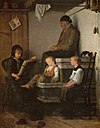
|
Sunday afternoon | 1861 | 82 × 65cm oil on canvas |
Musée d'art et d'histoire, Neuchâtel |

|
The school exam | 1862 | 103 × 175 cm oil on canvas |
Art Museum Bern |

|
Child funeral | 1863 | 111 × 171 cm oil on canvas |
Aargauer Kunsthaus |

|
The knuckle players | 1864 |
Oil on canvas |
|

|
The bathers | 1865 | 64 × 123.5 cm oil on canvas |
|

|
Girl feeding the chickens | 1865 | 66 × 51 cm oil on canvas |
Musée d'art et d'histoire, Neuchâtel |

|
The farmers and the newspaper | 1867 | 64 × 80.5 cm oil on canvas |
Privately owned |

|
The exiles | 1868 | 62 × 50 cm oil on canvas |
|
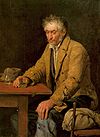
|
The drinker | 1868 | 69 × 50 cm oil on canvas |
Art Museum Bern |

|
The Kappeler milk soup | 1869 | 97 × 137 cm oil on canvas |
Privately owned |

|
Ruedi Anker on his deathbed | 1869 | 103 × 175 cm oil on canvas |
Collection Christoph Blocher |

|
Heinrich Pestalozzi and the orphans in Stans | 1870 | 95 × 73 cm oil on canvas |
Kunsthaus Zurich |

|
The Bourbaki Army | 1871 | 95 × 151 cm oil on canvas |
Musée d'art et d'histoire, Neuchâtel |

|
The school walk | 1872 | 90 × 150 cm, oil on canvas |
Collection Christoph Blocher |

|
The pile dweller | 1873 | 65 × 81 cm oil on canvas |
Musée de Beaux-Arts, La Chaux-de-Fonds |

|
The soap blower | 1873 | 45 × 32 cm oil on canvas |
Art Museum Bern |

|
Tea and bread rolls | 1873 | 33 × 3 48 cm oil on canvas |
Solothurn Art Museum |

|
The parish clerk |
1874 | 64.5 × 51 cm oil on canvas |
Privately owned |

|
The artist's daughter Louise |
1874 | 64.5 × 51 cm oil on canvas |
Oskar Reinhart Museum in Winterthur |

|
Young mother looking at her sleeping child by candlelight | 1875 | 36.5 × 46.5 cm oil on panel |
|

|
Girl with jumping jack (Marie Anker) | 1875 | 35.5 × 30 cm oil on canvas |
|

|
Country children | 1876 | 111 × 175 cm oil on canvas |
Musée d'art et d'histoire, Neuchâtel |

|
Still life: coffee and cognac | 1877 | 34 × 46 cm oil on canvas |
Winterthur Art Museum |

|
Gym lesson in Ins |
1879 | 96 × 147.5 cm oil on canvas |
Collection Christoph Blocher |

|
Children's breakfast | 1879 | 65 × 81 cm oil on canvas |
Art Museum Basel |

|
Schoolboy | 1881 | 56 × 42.5 cm oil on canvas |
Oskar Reinhart Museum in Winterthur |

|
Hip picture of a girl (Marie Anker) | 1881 | 65 × 81cm oil on canvas |
Art Museum Bern |

|
Little Red Riding Hood | 1883 | 62 × 65 cm oil on canvas |
|
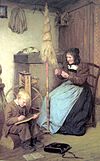
|
The working names | 1883 | 86 × 55.5 cm oil on canvas |
Privately owned |
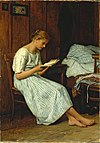
|
A Gotthelf reader | 1884 | 59 × 42 cm oil on canvas |
|
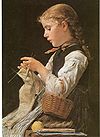
|
Knitting girl | 1884 | 65 × 46.5 cm oil on canvas |
|

|
The grandfather tells a story | 1884 | 74 × 109 cm oil on canvas |
Art Museum Bern |

|
The pile dweller | 1886 | 65 × 81 cm oil on canvas |
Winterthur Art Museum |

|
The little potato peeler | 1886 | 71 × 53 cm
Oil on canvas |
Privately owned |

|
Reading girl (Cécile Anker) | September 12, 1886 | 16.5 × 25 cm brush and pen in blue faience paint |
Privately owned |

|
Girl braiding her hair | 1887 | 70.5 × 54cm oil on canvas |
Privately owned |

|
Civil wedding | 1887 | 76.5 × 127 cm oil on panel |
|
|
|
Reclining female nude | 1887 | 17 × 45 cm oil on canvas |
Privately owned |

|
Chiusi | 1887 |
watercolor |
Privately owned |

|
Queen Bertha and the spinners | 1888 | 86 × 126.5 cm oil on canvas |
Museée Cantonal des Beaux Arts, Lausanne |

|
The older sister | around 1889 | 66 × 46 cm, oil on canvas | Koller auction house, Zurich 2011 |

|
The kindergarden | 1890 | 80 × 141 cm oil on canvas |
Oskar Reinhart Museum in Winterthur |

|
The little knitters | 1891 | 62 × 68.5 cm, oil on panel | Oskar Reinhart Museum in Winterthur |

|
Portrait of a boy | around 1891 |
Oil on canvas |
Collection Christoph Blocher |

|
Castello San Giorgio in Mantua | 1891 |
watercolor |
Privately owned |

|
Grandfather's devotion | 1893 | 63 × 92 cm oil on canvas |
Kunstmuseum Bern , Bernese Art Society |

|
Two sleeping girls on the stove bench | 1895 | 55.5 × 71.5 cm oil on canvas |
Kunsthaus Zurich |

|
The village school from 1848 | 1896 | 104 × 175.5 cm oil on canvas |
Art Museum Basel |

|
Still life - immoderation | 1896 | 48 × 62 cm oil on wood |
Collection Christoph Blocher |

|
Still life: tea and melted rolls | 1896 | 42 × 51 cm oil on canvas |
|

|
Sleeping boy in the hay | 1897 | 55 × 71 cm oil on canvas |
Art Museum Basel |

|
Still life: beer and radish | 1898 | 32.5 × 52 cm oil on canvas |
Kunstmuseum Bern Deposit from the Gottfried Keller Foundation |

|
Toddler school on the Kirchenfeldbrücke | 1900 | 76 × 127 cm | Art Museum Bern |

|
Advertiser at the table | 1908 | 33.5 × 24.5 cm watercolor |
|

|
The absinthe drinker | 1908 |
Oil on canvas |
|

|
Self-portrait | around 1908 | 48 × 38 cm oil on canvas |
Art Museum Bern |

|
The girl with the dominoes | between 1850/1900 | Diameter 37 cm, oil on panel | Privately owned |

|
The Erbeer Mareili | 35 × 25 cm watercolor |
Privately owned | |

|
Girl in front of a window niche | 35 × 25 cm oil on canvas |
Privately owned | |
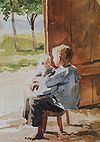
|
Insert boy with siblings | undated |
watercolor |
The largest private collector of Anker works is Christoph Blocher .
Anchor house
The house in which Anker was born, grew up and lived and worked after 1890 is in the middle of the village of Ins. It was built in 1803 by Albert's father, the veterinarian Rudolf Anker, in the style of Zeeland farmhouses. The house layout and furnishings largely correspond to the original condition. Anker's studio has remained almost unchanged; as well as numerous objects that Anker depicted in his pictures. The house belongs to Anker's descendants, the Brefin family, who live in and look after it. The family is supported by the Albert-Anker-Haus Ins foundation founded in 1994. House and studio can be visited.
literature
- Margarete Braun-Ronsdorf: Anker, Albert. In: New German Biography (NDB). Volume 1, Duncker & Humblot, Berlin 1953, ISBN 3-428-00182-6 , p. 298 ( digitized version ).
- Helmi Gasser : The painter Albert Anker visits Heinrich Max Imhof in Altdorf. In: Historisches Neujahrsblatt / Historischer Verein Uri , Vol. 105, 2014, pp. 121–130.
- Robert Meister (Ed.): Albert Anker and his world. Zytglogge-Verlag, Bern 1981.
- Hans A. Lüthy, Paul Müller: Albert Anker, watercolors and drawings. NZZ-Verlag, Zurich 1989.
- Sandor Kuthy and others: Albert Anker. Orell Füssli Verlag, Zurich 1980.
- Isabelle Messerli: "... if dreams then constantly lead me to studios at night ...?" In: Albert Anker - Paths to Work. Catalog for the Albert Anker 2000 exhibition in Ins. Ins 2000. pp. 63-68.
- Therese Bhattacharya-Stettler, Marc Fehlmann, Matthias Frehner (eds.): Albert Anker and Paris. Exhibition catalog Kunstmuseum Bern. Bern 2003.
- Therese Bhattacharya-Stettler (Ed.): Albert Anker. Exhibition catalog Fondation Pierre Gianadda. Martigny 2003/2004 (French / German)
- Isabelle Messerli: Albert Anker: His studio - his props - his models. In: Anchor. Catalog Exposition Fondation Pierre Gianadda. Martigny 2003/2004. Pp. 65-73. (French / German)
- Isabelle Messerli: Toy inventory . Albert Anker House Ins Foundation, Bern 2007. (Unpublished)
- Isabelle Messerli: Anker as Draftsman and Watercolorist . In: Albert Anker. Exhibition in Japan: The Bunkamura Museum of Art, Koriyama City Museum of Art, Matsumoto City Museum of Art, Museum Eki, Kyoto in cooperation with The Museum of Fine Arts, Bern, Switzerland. December 1, 2007 - June 22, 2008. Tokyo 2007. pp. 29-30. (Engl./Jap.)
- Isabelle Messerli: Education and Learning . In: Albert Anker. Exhibition in Japan: The Bunkamura Museum of Art, Koriyama City Museum of Art, Matsumoto City Museum of Art, Museum Eki, Kyoto in cooperation with The Museum of Fine Arts, Bern, Switzerland. December 1, 2007 - June 22, 2008. Tokyo 2007. pp. 106-127. (Engl./Jap.)
- Isabelle Messerli: Play to Learn . In: Albert Anker. Exhibition in Japan: The Bunkamura Museum of Art, Koriyama City Museum of Art, Matsumoto City Museum of Art, Museum Eki, Kyoto in cooperation with The Museum of Fine Arts, Bern, Switzerland. December 1, 2007–22. June 2008. Tokyo 2007. pp. 88-105. (Engl./Jap.)
- Isabelle Messerli: Queen Bertha and the spinners by Albert Anker. In: Society for Swiss Art History (Ed.): Art and Architecture in Switzerland. Issue 4, Bern 2006. pp. 58–61.
- Kunstmuseum Bern (Ed.): Catalog for the 2010 exhibition: Albert Anker - Beautiful World. (With essays by Therese Bhattacharya-Stettler, Matthias Frehner, Isabelle Messerli.) Stämpfli Verlag, Bern.
- Rural society and material culture with Albert Anker. Reprint of the Berner Zeitschrift für Geschichte , issue no. 2, 2010. In cooperation with the Albert Anker-Haus Ins foundation and the art museum. Bern.
- Peter Meyer : To a table work about Albert Anker In: Architektur und Kunst , Vol. 28, Issue 11, 1941, pp. 207-310.
Web links
- Albert Anker in the catalog of the Burgerbibliothek Bern
- Publications by and about Albert Anker in the Helveticat catalog of the Swiss National Library
- Literature by and about Albert Anker in the catalog of the German National Library
- Works by and about Albert Anker in the German Digital Library
- Therese Bhattacharya-Stettler: Anker, Albert. In: Historical Lexicon of Switzerland .
- Therese Bhattacharya-Stettler: Anker, Albert. In: Sikart (status: 2018), accessed on February 23, 2018.
- Website of the Albert Anker House in Ins
- Lydia Brefin tells about the life of the painter (1886) on YouTube in the Anker House in Ins
- Website for the exhibition Albert Anker and Realism in Switzerland. March to September 2013, Museum zu Allerheiligen , Schaffhausen
Individual evidence
- ^ Sandor Kuthy, Therese Bhattacharya-Stettler: Albert Anker, 1831-1910. Catalog of works of paintings and oil studies . Wiese Verlag and Kunstmuseum Bern , Bern 1995, ISBN 3-909164-40-4 , p. 21.
- ↑ Bust for Albert Anker
- ↑ winterthur tourism. (No longer available online.) Formerly in the original ; accessed on December 5, 2019 . ( Page no longer available , search in web archives )
- ↑ Isabelle Messerli: "... if dreams then constantly lead me to studios at night ...?" In: Albert Anker - Paths to Work. Pp. 63-68.
- ↑ Marc Fehlmann: Albert Anker - Dessinateur. In: Albert Anker. Exhibition catalog Fondation Pierre Gianadda, Martigny 2003, pp. 173–227.
- ↑ Marc Fehlmann: Albert Ankers Babylonian Captivity. His Gotthelf illustrations for the Neuchâtel publisher Frédéric Zahn. In: Peter Gasser and Jan Loop (eds.): Gotthelf. Interdisciplinary approaches to his work. Peter Lang, Bern / Frankfurt am Main 2009, pp. 77–120.
- ^ Isabelle Messerli, In: Albert Anker - Paths to the work. Pp. 63-68.
- ^ Website Albert-Anker-Haus. Retrieved December 5, 2019 .
- ^ Exhibition information from the Kunstmuseum Bern . Retrieved May 8, 2014.
- ↑ Individual articles as PDF at BEZG-online . Retrieved May 8, 2014.
| personal data | |
|---|---|
| SURNAME | Anker, Albert |
| ALTERNATIVE NAMES | Anker, Albert Samuel |
| BRIEF DESCRIPTION | Swiss painter |
| DATE OF BIRTH | April 1, 1831 |
| PLACE OF BIRTH | Ins |
| DATE OF DEATH | July 16, 1910 |
| Place of death | Ins |









